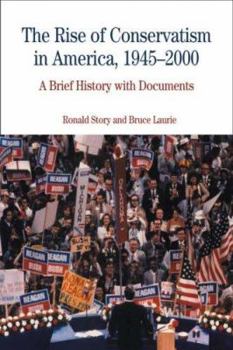The Rise of Conservatism in America, 1945-2000: A Brief History with Documents
Rise of Conservatism in America, 1945-2000 utilizes speeches, cartoons, party platforms, and editorials to trace the remarkable impact of the conservative movement in the last half of the twentieth century.
Format:Paperback
Language:English
ISBN:0312450648
ISBN13:9780312450649
Release Date:March 2007
Publisher:Bedford Books
Length:208 Pages
Weight:0.50 lbs.
Dimensions:0.3" x 5.5" x 8.2"
Customer Reviews
2 ratings
An Excellent Introduction to the History of American Conservatism
Published by Thriftbooks.com User , 14 years ago
This striking collection of documents, introduced with a cogent and thought-provoking introductory essay, does a creditable job of explaining how the conservative movement has reemerged in the last few years to dominate the political and cultural, to say nothing of the economic, landscape at the turn of the millennium. Historians Ronald Story and Bruce Laurie draw this relate from the backlash over the New Deal through the post-war era into the Cold War and beyond. Their succinct narrative is an excellent introduction to this important subject. They divide the work into three parts. The first part, entitled "First Steps," describes the manner in which modern conservatism emerged from the New Deal and World War II era to create a viable set of ideas as a challenge to the New Deal liberalism of FDR and the Democrats. This era was dominated by thinkers and writers such as William F. Buckley, Milton Friedman, and others, and the formation of an ideology that galvanized the political right. The anti-communist mindset was established in this era, and the Cold War mentality of opposition to the Soviet Union and the celebration of capitalism and democracy assumed supremacy in the conservative movement. These conservative thinkers also raised to a high level the ideal of libertarianism as reflecting a longstanding respect for individualism and liberty. In practical terms this required the opposing of big government programs and the redistribution of wealth through such programs as Social Security. There was a divergence of opinion among conservative thinkers, of course, and no one should try to pigeonhole William F. Buckley and Ayn Rand as identical in their ideology. The classic political exposition of this new conservatism was Barry Goldwater, the principled Arizona conservative who suffered a debacle in the 1964 presidential election. After that defeat, the conservative movement began to retrench and the second part of the book deals with the period between 1964 and 1980. Confident of their ideas they did not question those, but their strategies evolved. Less well known conservatives such as Lewis F. Powell Jr., Kevin Phillips, Richard Viguerie, and Irving Krystal emerged to lead efforts to build coalitions that could win elections. The establishment of a series of important think tanks--the Cato Institute, the Heritage Foundation, and a number of others--organized the mental horsepower toward strategies for success at the ballot box. The result was that by 1980 the conservative movement stormed into leadership on the national stage. With Ronald Reagan as the standard bearer taking office just as the New Deal coalition was breaking down, the conservative movement pursued policies aimed at deregulating business and unleashing the "free market." During this period the conservative coalition incorporated big business elites with social conservatism residing in the evangelical Christian churches. This proved a powerful force for winning elections. In th
A good way of understanding the process through which conservatism ended up changing United States'
Published by Thriftbooks.com User , 16 years ago
"The Rise of Conservatism in America, 1945-2000: A Brief History with Documents" is an engaging book that manages the commendable feat of conveying interesting ideas in a clear and succinct way. This book begins with a background essay about the rise of conservatism in America, an essay that is highly useful in order to contextualize the different documents that follow it. In this essay, Ronald Story and Bruce Laurie support the idea that the emergence of the conservative movement is the central story of American politics since World War II, and give convincing arguments that corroborate this premise. Nowadays, it is easy to see the consequences of this phenomenon in American politics if we view things from a historical perspective. In the authors' words, "Conservatism decisively shifted the nation's center of political gravity to the right. Politics increasingly played out within a framework constructed by the conservative movement, just as politics in the 1950s still operated within the framework constructed by the New Deal coalition." The essay is followed by a selection of documents regarding the period. It is easy to see that they have been carefully chosen by the authors in order to allow the reader to follow the process they are talking about and to judge for themselves after reading primary sources. The documents are organized according to what the authors consider the different periods of the conservative movement: "first steps" (1945-1968), "expanding the base" (1968-1980) and "clean sweep" (1980-2000). On the whole, I can say that I strongly recommend this book as a good way of understanding the process through which conservatism ended up changing United States' political culture. Belen Alcat





